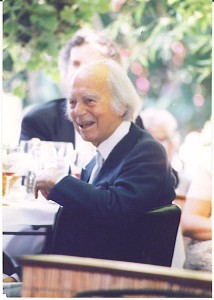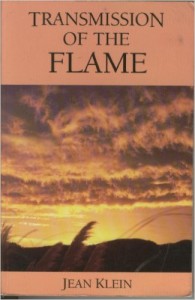 I studied with Advaita master Jean Klein for approximately three years both in the United States and England. I took part not just in weekend intensives in New York and Berkeley and other locations, but also in extensive retreats in Joshua Tree, CA, as well as in England.
I studied with Advaita master Jean Klein for approximately three years both in the United States and England. I took part not just in weekend intensives in New York and Berkeley and other locations, but also in extensive retreats in Joshua Tree, CA, as well as in England.
People frequently ask me about the esoteric form of yoga Jean Klein taught and the role of the body in his non-dual teachings. The following book review explores some of the reasons that Jean believed it was important to undertake the subtle, energy-oriented bodywork that he brought us.
Jean Klein, the remarkable Advaita Vedanta master, who was also a medical doctor and accomplished violinist, died on February 22, 1998.
Those who are searching for truth and meaning and who did not have an opportunity to meet him and work with him would do well to read some or all of his many wonderful books.
 In his book Transmission of the Flame, for instance, we have the opportunity to relive in ourselves the illuminating dialogues that took place between Jean Klein and his students during seminars in Holland, America, England, and France in 1988-89.
In his book Transmission of the Flame, for instance, we have the opportunity to relive in ourselves the illuminating dialogues that took place between Jean Klein and his students during seminars in Holland, America, England, and France in 1988-89.
But these are no ordinary dialogues. As we listen closely, and as we try to understand, we see that it is finally only through living in a deep, silent “not knowing” that we can awaken to our fundamental nature, to the “I am” of pure consciousness.
Until the publication of this book, little was known publicly about Jean Klein’s history and awakening. This book, however, includes a fascinating prologue in which he discusses certain key events of his life, including some meetings with his teacher in India.
Although Advaita has to do with the realization that we are not the mind, body, and senses, that we are the consciousness the lies behind, at the core of Jean Klein’s teaching one find great emphasis on both the body and the “energy body,” or “vital body.” Jean Klein tells us in the prologue why he emphasized so much this work with what we are not. After returning from India, he says, “It became apparent, through meeting people, that identification with what we are not is confirmed and reinforced by contraction on the psychosomatic level. The I-concept is only a contraction on the level of the body-mind. It has no more reality than a bad habit. It is a defense against being nobody. … In getting to know the body-mind, one can discover more clearly the nature of the identification, and so let it go. The relaxed body is a relaxed mind. In a relaxed body and mind you are open to receiving, available, welcoming, open to the openness. The relaxed, light, energetic, sattvic body-mind are a near expression of your real nature.”
Later, in response to a question about the “vital body,” Jean Klein says “When you close your eyes for a moment and detect the subtle body, you will realize that your body is not limited by the formation of the skin, of the bone-muscle structure. You will feel yourself expanded. I myself have no idea or sensation of my body being limited. Whether my eyes are open or closed, I am everywhere, expanded in space.”
In this beautiful book, Jean Klein takes us beyond lineages, beyond techniques, and beyond our self-image to the underlying reality of global consciousness and being.
To further explore Jean’s approach to ”bodywork, I am including here something that Jean said in the July 1991 issue (Number 4) of his wonderful journal “Listening,” in the section “Body Approach” (you can find a compilation of 10 issues of the journal in The Book of Listening):
“The body is an object of our awareness; it is sensed; it takes place in our awareness. The body is in us, but we are not in the body. If we were we could not be aware of it. …”
“When we do the bodywork the sensation is felt and explored in our awareness. There is space between ‘I’ and the sensation. You are no longer stuck to it, the object. The goal of the bodywork is to make us aware of this space between the ‘I’ and the object, a space that is habitually cramped. This space between the object and ‘I’ is still in duality, but there comes a moment when the space is felt as our real nature, we abide in it, and the object, the sensation, appears in it.”